What is a Decimeter?
A decimeter is a unit of length or distance in the metric system.
You must be familiar with the customary units of length such as yards, feet, etc. Similarly, the metric system uses “meter” as a unit of measuring length. “Decimeter” is one of many subdivisions of the unit “meter.”
Let’s learn more about “decimeter,” its relationship with other units, and more.
Decimeter Definition
A unit in the metric system used to measure the length or distance. The prefix term, “deci” is derived from the Latin word “decimus,” meaning one-tenth. So, think about what part of a meter is a decimeter? It refers to one-tenth of a meter. The symbol of a decimeter is “dm.”
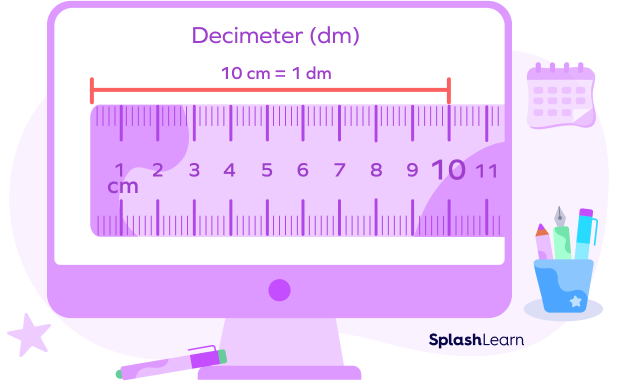
How Long is a Decimeter?
Understand that a meter is 100 cm, and one-tenth of 100 cm is 10 cm. So, one decimeter is 10 centimeters.
Similarly, one decimeter is equal to 100 millimeters.
The Metric System
The metric system is a system of weights and measures that use the meter (m), liter (l), and gram (g) as units of measuring length, volume/capacity, and mass/weight.
Unlike the Imperial/US customary units of length, volume, and mass, the metric units are invariant of space and remain constant throughout the world. For instance, the length of one meter of cloth is the same everywhere in the world. However, an inch measures 2.61 cm in Norway, 3.33 cm in China, and 2.54 cm in the US.
Decimeters and Other Units of Measurement
Decimeters and Metric Units
We can use the following conversion table to establish the relationship between metric units of measurement.
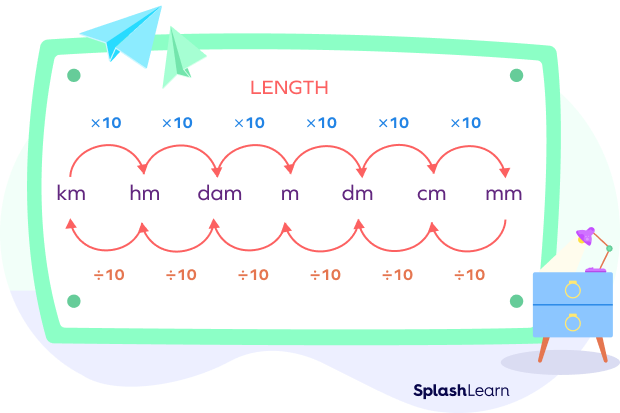
From the figure above, we can convert decimeter to meter and other metric units. For example, 10 decimeters make a meter.
Observe the table below to understand the relation between dm measurements and other metric units.
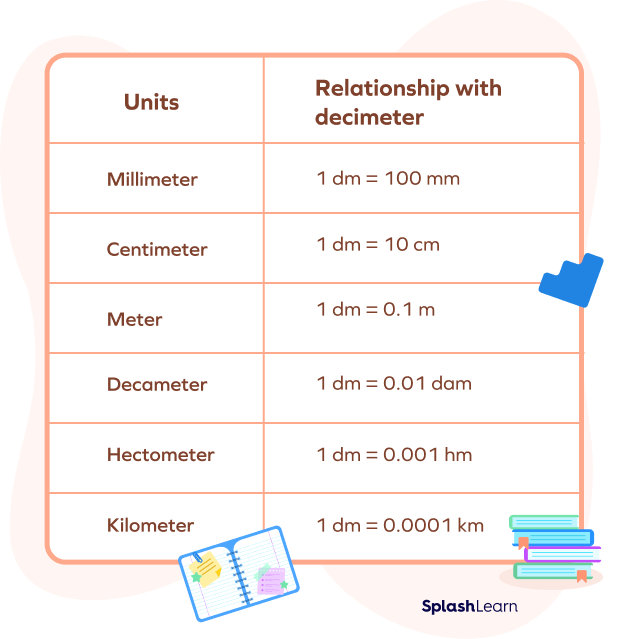
Decimeter and Imperial/US Customary Units
Let’s see the relationship between decimeters and other customary units of length. We can use the following chart to convert imperial units.
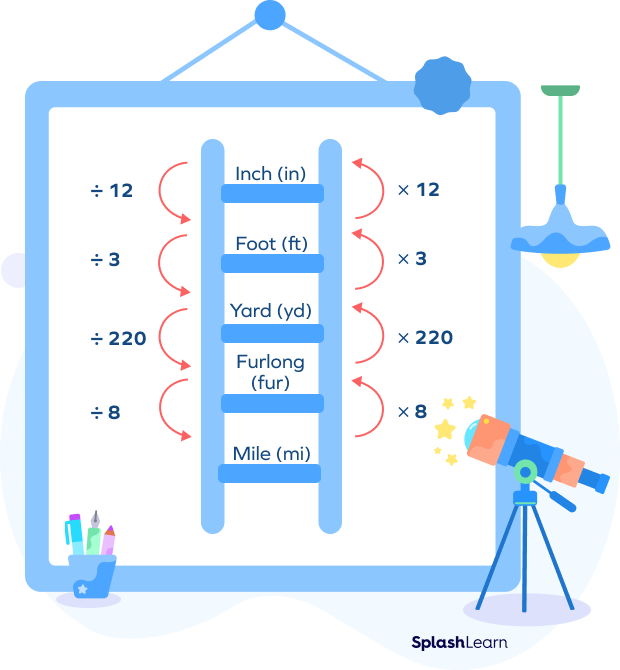
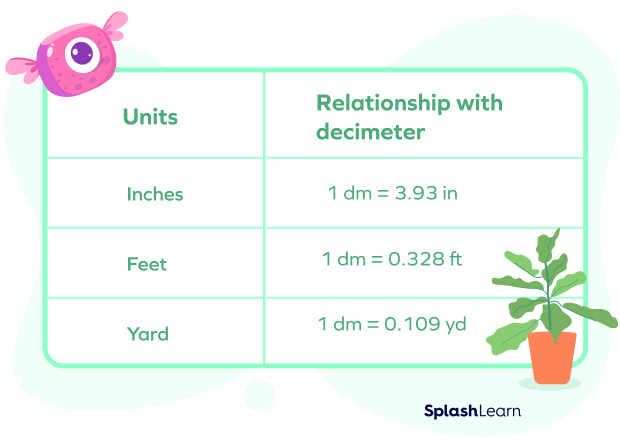
Decimeters and Liters
Volume refers to the space occupied by a body or its capacity to store a certain substance, such as liquids. We use liters to measure the volume/capacity of an object in the metric system. A liter is equal to 1 dm3 or 1000 cm3.
One liter $=$ one cubic decimeter
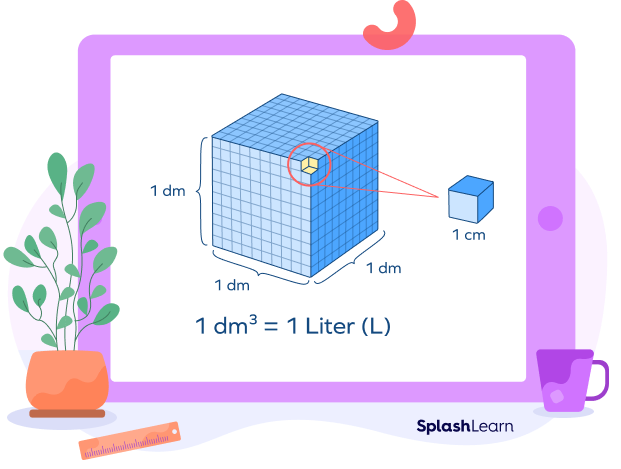
Fun Facts
- A decimeter is a unit larger than a millimeter and centimeter but less than a meter.
- In the increasing order of units of the metric system, the decimeter is in the third position, and further, the units increase up to kilometers.
Solved Examples on Decimeter
1. The length of a pen is 1.5 dm. Express it in centimeters.
Solution:
From the conversion chart, 1.5 dm $= 1.5 \times 10$ cm $= 15$ cm.
Therefore, the pen is 15 cm long.
2. Express 50 m in dm.
Solution:
From the conversion table, 1 m $= 10$ dm,
So 50 m $= 50 \times 10$ dm $= 500$ dm
3. Compare the following measurements using $\gt$, $\lt$ or $=$.
4.5 m $\underline{}$ 16 dm
Solution:
From the conversion table, 1 m $= 10$ dm
So, 4.5 m $= 4.5 \times 10$ dm $= 45$ dm
Therefore, 45 dm or 4.5 m $\gt$ 16 dm
4. Which is the longest, a 20 dm long ribbon, a 150 cm long rope, or a 1 m long lace?
Solution:
To compare two or more objects, we need to convert them into the same unit. Here, let us convert the units to decimeters to compare them.
From the conversion table, 1 cm $= 0.1$ dm
So, 150 cm $= 150 \times 0.1$ dm $= 15$ dm.
Similarly, 1 m $= 10$ dm
So, the ribbon is 20 dm long, the rope is 15 dm long, and the lace is 10 dm long. Therefore, the ribbon is the longest.
5. Express 1 foot in dm.
Solution:
From the conversion table, 1 dm $= 0.328$ ft.
1 ft $= 1 \div 0.328 = 3.048$ dm
Practice Problems on on Decimeter
Decimeter
Which of the following is equal to 5 hectometres?
From the conversion table, 5 hm $= 5 \times 1000$ dm $= 5,000$ dm
Which of the following is equal to 3000 dm?
From the conversion table, 3000 dm $= 300$ m $= 30$ dam $= 3$ hm $= 0.3$ km
Which of the following is the longest?
40 cm $= 4$ dm, 50 mm $= 0.5$ dm, 3 m $= 30$ dm
So, 50 mm $\lt 40$ cm $\lt 3$ m $\lt 40$ dm
Joe has a blue ribbon that’s 2 dm in length. Harry has a red ribbon that’s 15 cm in length. Tom has a purple ribbon that’s 0.2 m long. The total length of the ribbons is:
Joe has a blue ribbon that’s 2 dm long. Harry has a red ribbon that’s 15 cm or 1.5 dm long. Tom has a purple ribbon that’s 0.2 m or 2 dm long. So, the total length of the ribbon is $2$ dm $+ 1.5$ dm $+ 2$ dm or $5.5$ dm
Select a symbol that makes the statement true. 20 dm $\underline{}$ 20 dm $= 4$ m
4 m $= 40$ dm
So, 20 dm $+ 20$ dm $= 40$ dm $= 4$ m
Frequently Asked Questions on on Decimeter
How many decimeters are in a meterstick?
A meterstick is a straight-edge or folder ruler that’s one meter long. There are 10 decimeters in a meterstick since 10 dm make up 1 meter.
Which is larger: a decimeter or a decameter?
The prefix “deci” is a Latin origin term meaning one-tenth, and “deca” means ten times. So, a decimeter is one-tenth of a meter, and a decameter is 10 times a meter. Therefore, the decameter is the larger unit.
How many inches is one decimeter?
One decimeter is 3.9370 inches and 0.32808 feet.
Is a decimeter bigger than a centimeter?
The base unit of both decimeters and centimeters is the meter. The prefix “deci” is derived from the Latin “decimus” meaning one-tenth. A decimeter is one-tenth of a meter, and a centimeter is one-hundredth of a meter. Therefore, 1 dm is bigger than a centimeter.
















